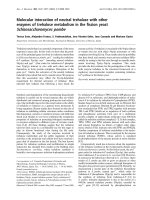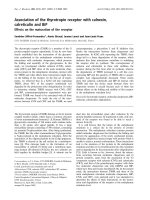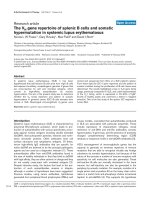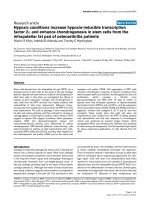Báo cáo y học: " Superior vena cava obstruction presenting with epistaxis, haemoptysis and gastro-intestinal haemorrhage in two men receiving haemodialysis with central venous catheters: two case reports" pot
Bạn đang xem bản rút gọn của tài liệu. Xem và tải ngay bản đầy đủ của tài liệu tại đây (348 KB, 3 trang )
Case report
Open Access
Superior vena cava obstruction presenting with epistaxis,
haemoptysis and gastro-intestinal haemorrhage in two men
receiving haemodialysis with central venous catheters:
two case reports
Seerapani Gopaluni* and Paul Warwicker
Address: Renal Unit, Lister Hospital, Stevenage, SG1 4AB, UK
Email: SG -
* Corresponding author
Published: 27 May 2009 Received: 24 February 2008
Accepted: 22 January 2009
Journal of Medical Case Reports 2009, 3:6180 doi: 10.1186/1752-1947-3-6180
This article is available from: />© 2009 Gopaluni and Warwicker; licensee Cases Network Ltd.
This is an Open Access article distributed under the terms of the Creative Commons Attribution License (
/>which permits unrestricted use, distribution, and reproduction in any medium, provided the original work is properly cited.
Abstract
Introduction: Superior vena cava (SVC) obstruction secondary to central venous catheterization is
an increasingly recognized complication.
Case presentation: We present two cases of superior vena cava obstruction secondary to
indwelling central venous catheters used for haemodialysis access. One of the patients developed the
unusual complications of torrential epistaxis and haemoptysis, which has been reported only once so
far in the literature. The other patient developed melaena secondary to downhill oesophageal varices.
We briefly discuss the pathophysiology, symptoms and signs, investigations and management of
superior vena cava obstruction and thrombosis.
Conclusion: Increasing use of central venous access for haemodialysis will increase the incidence of
central venous stenosis, thrombosis and exhaustion. Superior vena cava obstruction is likely to be an
increasingly recognised complication of vascular access in the future.
Introduction
Superior vena cava (SVC) obstruction and thrombosis
caused by indwelling venous catheters is a growing
problem, and is associated with an appreciable morbidity
and mortality. We present two cases of SVC obstruction
secondary to multiple central venous catheterizations. In
the first case this was complicated by haemoptysis and
torrential epistaxis. In the second this was complicated by
‘downhil l’ oesophageal varices, and gastro-intesti nal
bleeding, compounded by anti-coagulation.
Case presentations
Case 1
A 53-year-old man on haemodialysis presented with a
one-week history of worsening shortness of breath, facial
and arm swelling. He was receiving dialysis through
his right jugular vein via a tunnelled catheter. He had
previously undergone multiple vascular access proce-
dures for haemodialysis. He was on long-term antic-
oagulation for repeated thrombotic complications. A
week prior to his admission his warfarin had been
Page 1 of 3
(page number not for citation purposes)
temporarily stopped to facilitate peritoneal dialysis
catheter insertion.
A clinical diagnosis of SVC obstruction was made and
warfarin was restarted. This was confirmed on magnetic
resonance venous imaging, which showed extensive
thrombosis in the superior vena cava extending into
both brachiocephalic veins (Figure 1). Shortly afterwards
he developed significant haemoptysis and persistent
epistaxis, eventually requiring tracheal intubation and
respiratory support. The bleeding persisted despite rever-
sing the anticoagulation and anterior and posterior nasal
packi ng, bilateral spheno-palatine artery ligation and
cauterization of bleeding venous sites. He subsequently
died from complications.
Case 2
A 75-year-old man who presented with marked swelling of
his face and arms, shortness of breath on exertion and
lethargy. Two weeks earlier he had the fifth re-insertion of
a tunnelled right internal jugular haemodialysis catheter.
He also had a history of failed vascular access procedures,
including arterio-venous fistulas and synthetic grafts.
Again a clinical diagnosis of SVC obstruction was made
and warfarin was started. An attempted superior vena
cavagram was unsuccessful, despite injecting dye into both
arm veins - which demonstrated multiple collateral veins,
but no opacification of the central veins at all (Figure 2).
However, subsequent magnetic resonance venography
demonstrated a SVC stenosis, occluded by a clot surround-
ing his tunnelled venous catheter. A decision was made to
anticoagulate him for a period of four to six weeks before
attempting to withdraw the catheter, and in the interim to
start dialysis via a tunnelled femoral catheter. Two weeks
later he presented with melaena. His haemoglobin had
fallen from 11.6 to 6.3 g per dl. He was transfused and his
anti-coagulation was reversed. Emergency endoscopy
revealed enlarged and bleeding oesophageal ‘downhill’
varices (Figure 3). ‘Downhill’ oesophageal varices, in the
upper third of the oesophagus, are less common than
classical ‘uphill’ varices, caused by portal hypertension and
found in the lower third [1,2]. His jugular catheter was
removed without any complications, under fluoroscopic
screening and subsequently the bleeding settled. Follow-
ing the catheter removal the patient was well and the
swelling improved.
Discussion
Worldwide, a combination of under-provision of vascular
access surgery, late referral and co-morbidity cause
increasing numbers of our patients to utilize tunnelled
venous cath eters in the medium to long term. One
consequence of this will be the increasing incidence of
central venous stenosis, thrombosis and exhaustion. SVC
obstruction is likely to be an increasingly recognised
complication of vascular access in the future.
The pathophysiology is thought to be secondary to early
intimal injury associated with focal endothelial denudation
occurring with short-term central venous catheters [3], and
related to the position of the tip of the catheter, the site of
Figure 1. Magnetic resonance venography of central veins
of patient number one. There is loss of normal flow void
with extensive echogenic material in the SVC and both
brachiocephalic veins extending into the subclavians.
Figure 2. Bilateral simultaneous arm venography (Patient 2)
demonstrating multiple collateral veins, but no opacification of
the central veins.
Page 2 of 3
(page number not for citation purposes)
Journal of Medical Case Reports 2009, 3:6180 />insertion, the material, and predisposition to thrombosis
[4]. With long-term c atheter use, there is vein wall
thickening, increased smooth muscle cells and focal catheter
attachments to the vein wall with thrombus and collagen.
Conclusion
Clinicians should be aware of the clinical consequences of
SVC obstruction, which include facial and arm swelling,
dyspnoea, headache, dysphagia, cough, visual disturbance
but also, less commonly, hoarseness, epistaxis, syncope,
tongue swelling, upp er gastro-intestinal bleeding and
haemoptysis. Commo n s igns in clude face and neck
swelling, upper extremity swelling and dilated chest
collaterals.
Angiography , indirect evidence from ultrasonography
[4] and MRI are used to establish the diagnosis of SVC
obstruction.
Management needs to be individualized. In the first few
days of SVC thrombosis, removal of catheter, chemical or
mechanical thrombolysis of the clot [5] and/or venoplasty
and stenting [6] has been reported to resolve t he
symptoms. Thereafter, the chance of success is diminished,
and formal anticoagulation may run the risk of exacerbat-
ing bleeding from engorged collateral veins.
In both of our cases the risk of doing nothing (thrombo-
lysis and anti-coagulation being contraindicated by the life
threatening bleeding that characterised both patients) was
weighed against the potential benefit of reducing the
pressure dynamics of the upper body central veins.
Although we were all aware of the risk - it is notable that
the patient whose catheter was removed, survived. The risk
arising fr om thromboembolism, of early removal of
catheters, has been highlighted [4].
Abbreviations
SVC, superior vena cava; MRI, magnetic resonance
imaging.
Consent
Written informed consent was obtained from the patients
(or next of kin) for publication of this case report and
accompanying images. A copy of the written consent is
available for review by the Editor-in-Chief of this journal.
Competing interests
The authors declare that they have no competing interests.
Authors’ contributions
SG did the literature search and contributed to writing the
majority of the case reports. PW managed the patients,
edited the case reports and obtained the figures. Both
authors read and approved the final manuscript.
References
1. Alpana Chandra MD, Raymond Tso MD, Jacob Cynamon MD, Gregg
Miller MD: Massive Upper GI Bleeding in a Long-term
Hemodialysis Patient. Chest 2005, 128:1868-1873.
2. Greenwell MW, Basye SL, Dhawan SS, Parks MD, Acchiardo SR:
Dialysis catheter-induced superior vena cava syndrome and
downhill oesophageal varices. Clin Nephrol 2007, 67(5):325-330.
3. Forauer AR, Theoharis C: Histologic changes in the human vein
wall adjacent to indwelling central venous catheters. J Vasc
Interv Radiol 2003, 14:1163.
4. Campisi C, Biffi R, Pittiruti M: Catheter-related central venous
thrombosis: The development of a nationwide consensus
paper in Italy. JAVA 2007, 12(1):39-45.
5. Rose SC, Kinney TB, Bundens WP, Valji K, Roberts AC: Importance
of Doppler analysis of transmitted atrial waveforms prior to
placement of central venous access catheter. J Vasc Interv Radiol
1998, 9:927.
6. Carcao MD, Connolly BL, Chait P, Stain AM, Acebes M, Massicotte P,
Blanchette VS: Central venous catheter-related thrombosis
presenting as superior vena cava syndrome in a haemophilic
patient with inhibitors. Haemophilia 2003, 9(5):578-583.
7. Kovalik EC, Newman GE, Suhoc ki P, Knelson M, Schwab SJ:
Correction of central venous stenoses: use of angioplasty
and vascular wallstents. Kidney Int 1994, 45:1177.
Figure 3. Endoscopic appearance of distended veins in
the proximal oesophagus (downhill varices) in patient
number two.
Page 3 of 3
(page number not for citation purposes)
Journal of Medical Case Reports 2009, 3:6180 />









